Corporate software navigator: there is always a choice
There is always a choice, but it is difficult to make when there are many similar things, selection criteria and requirements in front of you. You need a navigator that will help you navigate the variety of options and make a free, reasonable decision.
There are several dozen types of corporate software for companies of different scale and different fields of activity. We rummaged in them for you. The essence of this article is to offer a brief guide to the most popular and versatile business programs. The choice is yours!

Yandeks.Kartinki
We presented the types of corporate software that we encounter most often on a single card (you can open an enlarged version in the current or new window).
')
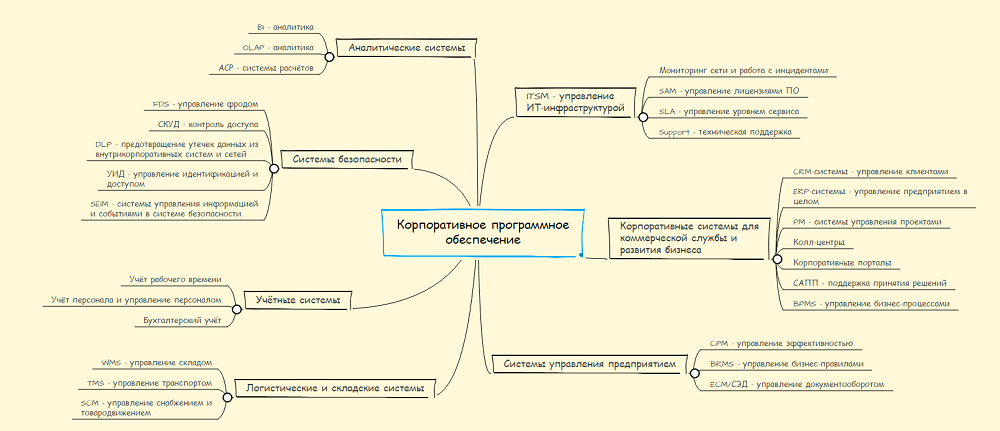
Map of the most popular corporate software. Clickable

Corporate Performance Management (CPM - not to be confused with CRM) - enterprise performance management systems that allow you to measure and manage organization performance. These complexes of metrics and methodologies have similar names - Enterprise Performance Management (EPM), Strategic Enterprise Management (SEM) and Business Performance Management (BPM). As a rule, it is a tool of financial managers and a financial director, aimed at performing a number of functions:
CPM systems are usually used in large companies with developed financial and managerial accounting and the need for deep financial management and analysis.
Business Rule Management System (BRMS) - business rule management systems that formalize decision-making logic, but not in the way that, for example, CRM systems do. The CRM system does not describe the business logic, but is based on it, that is, the logic is implemented in the program code of the system. BRMSs provide understandable descriptions of business logic that are understandable to all managers, not just IT professionals. The implementation can be quite primitive, even simpler than the business process: “if the contract is signed, then send it to the counterparty, otherwise run into Landox for re-approval”.
From the point of view of the software architecture, this is an application that includes a graphical interface for creating and editing business rules, information storage, analysis tools, and a rule execution server (a system engine that runs rules, sends reminders, etc.). extremely rare, most often included in BPMS, PM, CRM and DSS.
EDMS / EDMS / ECM (Electronic Content Management / Enterprise Content Management) - automated multi-user systems for managing digital documents and other types of corporate content that accumulate, store and deliver documents within the organization (and under certain conditions - and beyond). In its initial understanding, they include many functions: storage of documents, records, knowledge base, audit logs, events, works, etc., and their management.
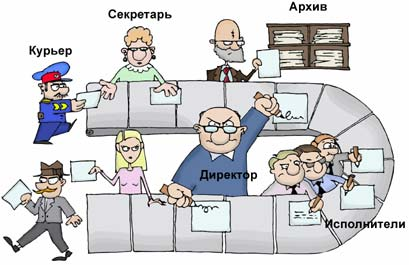
The workflow on which we grew, and SED-vendors have risen
In the Russian IT practice, the system of creation, storage and coordination of various documents is often understood as EDS. ECM-systems allow you to register documents and letters, perform joint actions with them, have a database of document information, effectively and very quickly search for documents, track the chains of their movement and coordination.
In Russia, the SED market is fairly densely divided, more than 40% of the market belong to one company. Partially, the elements of the ERMS are implemented in large ERP and CRM systems.

Enterprise Resource Planning, enterprise resource planning (ERP) - software systems that automate the largest processes in companies: finance, personnel, operations, asset management and production. Large ERP-systems include accounting, controlling functions, budget management, payroll, personnel records, working time accounting and much more. ERP-systems are used for large and geographically distributed companies that are striving for digital transformation and transparency of business processes.
As a rule, the implementation of ERP requires the most careful approach, since it covers several departments and various categories of users - these are enterprise management systems in general. The main mistake in the implementation of ERP systems is to implement it in a company that does not have a real need for such a solution.
Corporate portals - independent or integrated (for example, in CRM or ERP) systems for organizing internal work in companies: maintaining a list of personnel, communication, setting goals, discussing issues, training, etc. As a rule, corporate portals are considered not only as a working tool, but also as an element of corporate culture. With the right approach, they do not become an entertainment social network of the company, but are used precisely for accumulating, storing and sharing information, as well as for the adaptation and training of personnel.
Decision Support System (DSS, Decision Support Systems, DSS) - interactive software products that allow you to collect and analyze information for making management decisions. DSS automates the analysis of business metrics, forecasting the results of introducing new organizational and product solutions. The DSS uses various methods from decision theory - for example, the weighting method, arithmetic mean, factor analysis, decision trees, etc.

Almost a physical prototype of the DSS. The first prototype is toss a coin based on probability theory :-)
Architectural DSS includes three parts.
Today, DSS elements are integrated into other corporate information systems, such as ERP, CPM, CRM. However, some companies and even individuals use “clean” DSS systems in their activities.
Customer Relationship Management (CRM-systems) - complex software solutions that are aimed at automating customer relationship management. However, today these systems are closely intertwined with the SFA software class (Sales Force Automation) and have absorbed the functionality of other types of systems. Thus, CRM-systems (of course, large and developed) have become the most versatile software in demand in companies of various sizes. In the CRM-systems, the client base is accumulated with detailed information on each client, work with business processes and customer loyalty is taking place. It used to be that the main users of CRM were top managers and commercial services, but today CRM covers the requirements of almost every employee, including technical support. There are industry and specialized CRM-systems that are adapted to the business logic of a particular sphere.
CRM-systems of various vendors vary greatly in terms of capabilities: from a notebook to the level of an ERP system. For example, our RegionSoft CRM is divided into several editions that suit any company depending on its needs. Thus, the most "pumped" edition of RegionSoft CRM Enterprise Plus includes, in addition to standard modules, warehouse management, projects, production, can work with cash registers, bar codes, loyalty cards, builds reports, allows you to create primary documentation, KPI for employees and the company as a whole and so on
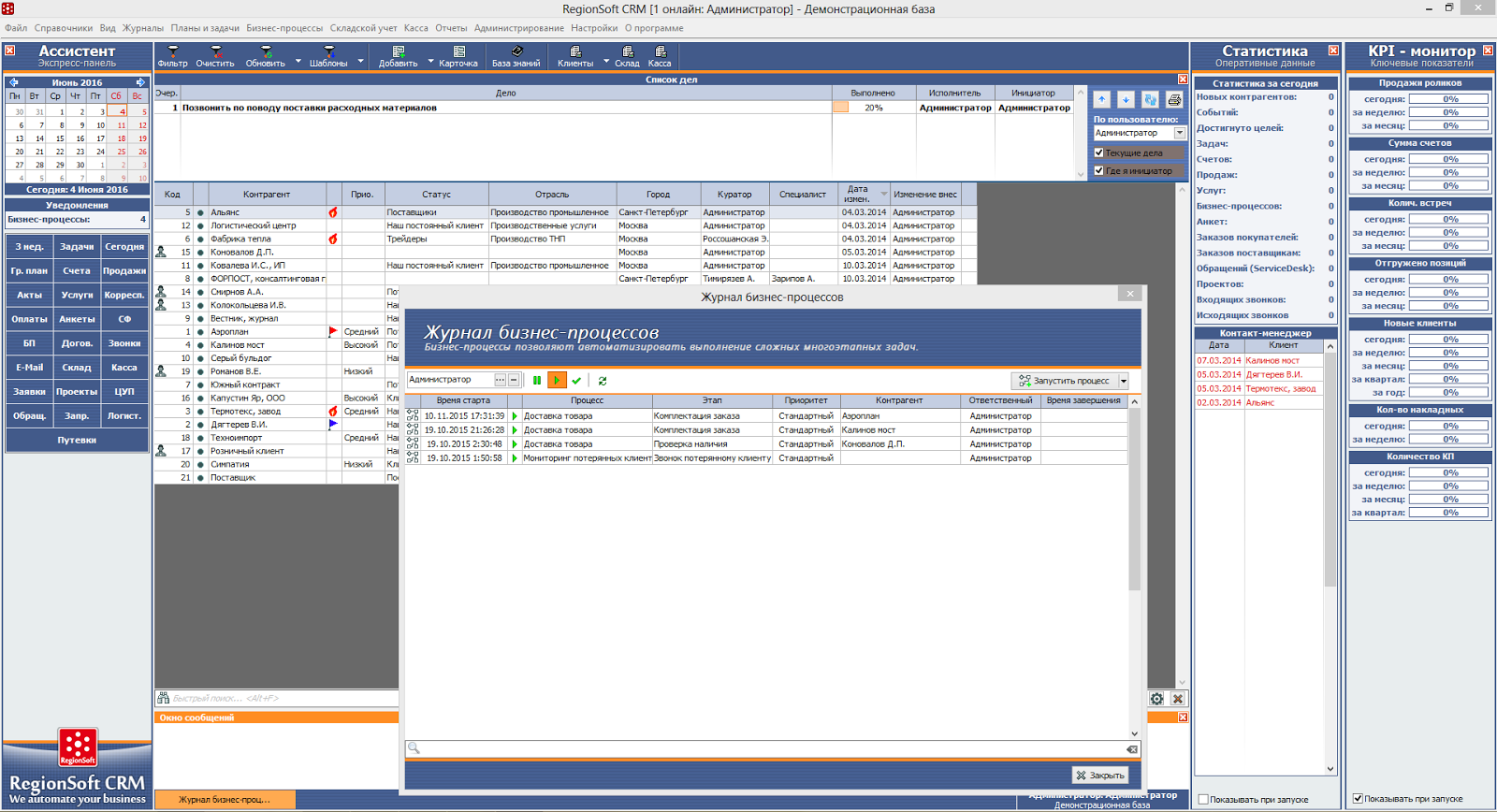
RegionSoft CRM main window. The logo can be changed to your company logo. Clickable
Correct CRM systems are integrated with accounting systems (1C), telephony, other software necessary for operational and analytical work in the company.
PM (Project Management) - systems that allow you to manage projects and tasks, with the division of tasks by responsible and deadlines. As a rule, in such systems, project finances, human and material resources are taken into account. The project management system also includes metrics, control parameters for the execution of tasks within the project, the ability to plan results, as well as resource loading.
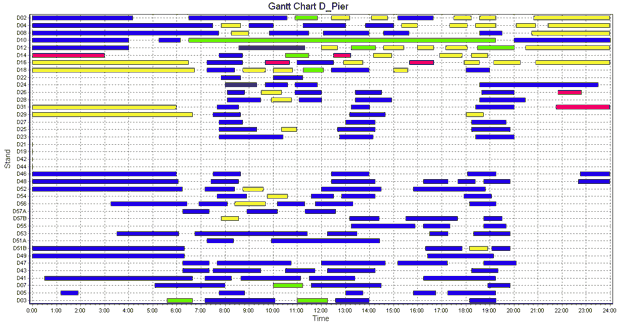
Favorite element of project management systems - Gantt chart
Systems differ significantly in scale (from production to those designed for a small startup team), goals and objectives (for example, there is a PM for development), and functional content.
Business Process Management System (BPMS) - business process management systems. This is a special type of software integrated into CRM / ERP / ECM, which considers each process in the company as a chain of sequentially performed actions with deadlines, responsible and trigger events at each stage. Using such systems, they model, launch and analyze business processes.
BPM systems allow you to create business process algorithms in special notations (BPMN 2.0) or in native editors (for example, we in RegionSoft CRM used a visual graphical process editor so that the maximum number of users without special training can create process instances).
Call-center (call centers) - call processing systems and customer calls. These are software and hardware-software complexes that are used for the purposes of sales, information and customer service. Most often, call centers either include the properties of CRM systems or integrate with them.

Source: Rusbase

Logistic information systems (LIS) - software that solves the problems of automation, management and optimization of warehouse and transport resources. This is a huge group of specialized software, which includes fleet management systems (FMS), maintenance and repair systems (TOiR or MRO), container transportation management systems (CTM), and multiple tracking and security systems. Among all the diversity, two types are especially distinguished: WMS and TMS.
Warehouse Management System (warehouse management systems) - specialized programs for warehouse automation. Depending on the configuration, they may include the management of the topology of warehouses, the commodity nomenclature and the distribution of goods (accounting, acceptance, shipment, inventory), planning, storage and processing of inventories. Such systems are a tool for storekeepers and warehouse logisticians who, with the help of automation, work with supplies and shipments, due to which commodity turnover grows, batches are quickly completed, and production is continuously supplied. The added value of such software is cost reduction by minimizing theft and other human factors.

Since the days of this poster storekeepers out of the confidence of managers. There is a warehouse - need a WMS
They can be supplied both autonomously and as part of large ERP and CRM systems. Such a module increases the cost of a CRM / ERP system, which is why separate editions are often highlighted (as in RegionSoft CRM ). If the warehouse is delivered in the basic edition of the system, it, as a rule, has a truncated set of possibilities.
Transport (ation) Management System (TMS) - transport management systems that automate the calculation of the cost of transporting goods by various types of transport, take into account the relationship with the customs, track deadlines and transportation routes. If the system works flawlessly, the manager in a few clicks can find out where the goods are located and when exactly it will be delivered. In a simplified form, we all came across similar systems when we were tracking our packages in mail service interfaces.
LIS is connected to another software group - Supply Chain Management (SCM) , whose solutions are designed to manage all stages of the company's supply and allow you to control the movement of goods. SCM, as software covering the entire process chain, covers the procurement, supply, production and distribution of goods. Through the use of such software, the level of service increases, the production cycle is optimized, inventory is reduced and regulated, the control of the production process becomes transparent. As a result, the cost of storage and logistics processes is reduced, the cost of production is reduced, and profitability is increasing.

BI (Business intelligence) - a whole section of tools and methods for analyzing structured and unstructured information, bringing it into a convenient form for the purpose of interpreting data to search for business opportunities. BI includes a large amount of internal and external information and differs from standard business intelligence metrics in a broader data coverage. Often, BI is placed above all types of intra-analytics. The term dates back to 1958 from the depths of IBM, and IBM continues to offer one of the most powerful solutions in this area - IBM Cognos.
Small and medium businesses do not often ask for full-fledged BI-systems, they are more often interested in banks, retailers, telecom operators, manufacturing companies. The domestic market of BI-systems develops mainly due to the own developments of corporations in the field of Big Data.
Online Analytical Processing (OLAP) - often BI-related systems for analytical information processing and business metrics in real time. Such systems allow you to select data and build on their basis reports, tables, samples. As a rule, commercial services of companies (sales and marketing) use this or that form of OLAP. The term “OLAP-cube” is quite common - a three-dimensional representation of these organizations with the ability to build trends, analytics, etc. (the so-called Data Mining - data collection for the search for patterns). In turn, OLAP is divided into:
OLAP-systems are independent and built into complex complex corporate software (billing systems, ERP, CRM). Often, CRM vendors blame the presence of OLAP, but you should definitely clarify what kind of OLAP they mean - in actual fact, this may be the usual tabular presentation of data.
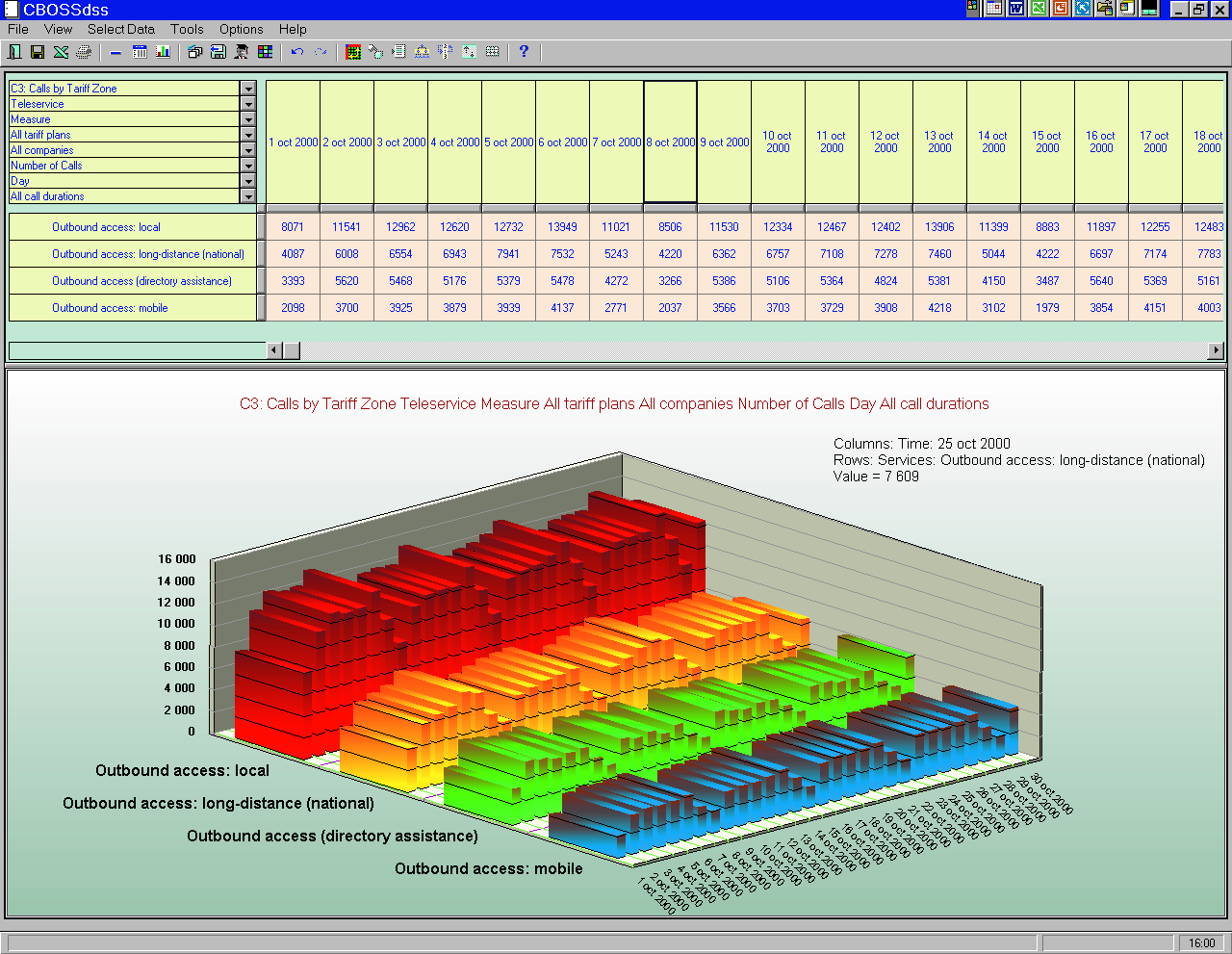
OLAP implementation in the legendary DSS CBOSS (used in telecom operators). Very well traced three-dimensional representation of the data.
Billing, automated settlement systems (ASR) is a software package for recording the cost, volume and profile of services consumed by subscribers and subscribers of services, which ensures settlements with customers in a given mode. Previously, billing systems were considered exclusively in relation to mobile operators and Internet providers, which traditionally take into account in the billing tariffs for services, conduct mutual settlements with subscribers, partners, dealer network. Nowadays, ASR has become a popular software for e-commerce - online stores accept bill payment through such systems. Sometimes billing systems are used by companies that provide complex services with hourly rates (auditors, outsourcers in IT, etc.)
Often, large companies seek to integrate billing with a CRM system in order to analyze the financial and subscriber profile of their customers. These are complex expensive projects that, when achieved success in implementation, give a positive economic effect.

ITSM (IT Service Management) or rather, software for implementing ITSM, is a separate class of IT service management software that falls out of the list of operational software, but is nevertheless extremely important for a company of any scale (though this is not all). understand). Strictly speaking, it is a variety of software that allows you to manage your IT infrastructure in terms of the best practices and the ITIL library. In the ITSM philosophy, the customer of the services is either the business itself (employees) or the client is outsourced, and the contractor is the IT service.
Programs for ITSM have many different versions, but most often include:
In the case of ITSM, the simple formula “ITIL you may not know, ITSM is obliged to create” works: the introduction of IT monitoring and management systems at the current level of technology development and penetration becomes an important issue for companies of any size.

Security Information and Event Management (SIEM) - security information and event management systems. These are programs that are designed to analyze threats to information security in IT systems in real time, to notify interested parties. This group includes various solutions in the field of information security: control and authentication systems, event logs, antiviruses, intrusion identification systems, risk management systems, traffic accounting, and so on.
Only 10 years ago, only very large businesses used these systems, today there are a lot of such companies, although the fact that organizations still don’t select cloud-based corporate services remains sad, so they don’t ask any questions about security - as if they don’t there are competitors, unscrupulous employees, and business has the opportunity to survive and get a new life.
Among such systems, several options are most widely used.
Fraud Detection System (FDS) - software systems that can detect fraud, as well as money and data leaks due to criminal acts or omissions of employees, contractors, subscribers, customers, etc. Such systems are rarely found in small companies, the main customers are banks, mobile operators, online stores, payment platforms.
Access Control Systems (ACS) - hardware and software systems for limiting the circle of people and transport that have access to the object (any limited area). ACS consists of a software control part, physical devices, identification devices (fingerprint scanners), controllers and an Ethernet network (if necessary, “communicating” devices with each other), video surveillance systems. Used in almost every company.
Data Loss Prevention (DLP) - software and hardware-software systems and technologies to prevent leakage of confidential information from corporate systems of companies. By the way, despite the fact that DLP is mostly positioned as software, in fact it is a complex of measures and processes (just as ITSM cannot be called software).
Technically, this is software that detects and blocks confidential information leaks in real time. DLP products can monitor email with any type of traffic, the web (including mail services and all types of encryption), peer-to-peer clients, chat rooms and instant messengers, network and local printers, external peripherals and memory cards, IP telephony, Wi-Fi transmitters and bluetooth. Also, the software of this class must necessarily be able to analyze the context of the transmitted data, look for the created copies on local and network devices.
Identity and Access Management (IAM, AMS (Authentication Management Systems), UID) - identity and access management systems, that is, establishing the fact that the subject of access belongs to the entered identifier. IAM systems require precisely defined business roles of employees, with the scope of rights and tolerances. In this software, along with passwords, NFC tags, fingerprints, voice, etc. can be used as an identifier.
In general, regardless of the type of corporate software, there is one practical advice: choose software based on the real needs of your business, think over the requirements, create a managed IT infrastructure. The main thing is that the path to automation does not turn into a labyrinth.
There are several dozen types of corporate software for companies of different scale and different fields of activity. We rummaged in them for you. The essence of this article is to offer a brief guide to the most popular and versatile business programs. The choice is yours!

Yandeks.Kartinki
We presented the types of corporate software that we encounter most often on a single card (you can open an enlarged version in the current or new window).
')

Map of the most popular corporate software. Clickable
Business Management Systems

CPM
Corporate Performance Management (CPM - not to be confused with CRM) - enterprise performance management systems that allow you to measure and manage organization performance. These complexes of metrics and methodologies have similar names - Enterprise Performance Management (EPM), Strategic Enterprise Management (SEM) and Business Performance Management (BPM). As a rule, it is a tool of financial managers and a financial director, aimed at performing a number of functions:
- financial planning and forecasting - in order to create a company's budget and determine the main directions of revenues and expenses
- strategic planning - the creation of financial models based on the analysis of the flow of income and expenses (here the system often works with KPI)
- financial and management reporting - creating reports for summarizing the period, as well as presentations to the management
- Formation of consolidated financial statements - aggregation and presentation of data for analysis, audit, reporting to government agencies.
CPM systems are usually used in large companies with developed financial and managerial accounting and the need for deep financial management and analysis.
BRMS
Business Rule Management System (BRMS) - business rule management systems that formalize decision-making logic, but not in the way that, for example, CRM systems do. The CRM system does not describe the business logic, but is based on it, that is, the logic is implemented in the program code of the system. BRMSs provide understandable descriptions of business logic that are understandable to all managers, not just IT professionals. The implementation can be quite primitive, even simpler than the business process: “if the contract is signed, then send it to the counterparty, otherwise run into Landox for re-approval”.
From the point of view of the software architecture, this is an application that includes a graphical interface for creating and editing business rules, information storage, analysis tools, and a rule execution server (a system engine that runs rules, sends reminders, etc.). extremely rare, most often included in BPMS, PM, CRM and DSS.
ECM
EDMS / EDMS / ECM (Electronic Content Management / Enterprise Content Management) - automated multi-user systems for managing digital documents and other types of corporate content that accumulate, store and deliver documents within the organization (and under certain conditions - and beyond). In its initial understanding, they include many functions: storage of documents, records, knowledge base, audit logs, events, works, etc., and their management.

The workflow on which we grew, and SED-vendors have risen
In the Russian IT practice, the system of creation, storage and coordination of various documents is often understood as EDS. ECM-systems allow you to register documents and letters, perform joint actions with them, have a database of document information, effectively and very quickly search for documents, track the chains of their movement and coordination.
In Russia, the SED market is fairly densely divided, more than 40% of the market belong to one company. Partially, the elements of the ERMS are implemented in large ERP and CRM systems.
Corporate systems for commercial service and business development

ERP
Enterprise Resource Planning, enterprise resource planning (ERP) - software systems that automate the largest processes in companies: finance, personnel, operations, asset management and production. Large ERP-systems include accounting, controlling functions, budget management, payroll, personnel records, working time accounting and much more. ERP-systems are used for large and geographically distributed companies that are striving for digital transformation and transparency of business processes.
As a rule, the implementation of ERP requires the most careful approach, since it covers several departments and various categories of users - these are enterprise management systems in general. The main mistake in the implementation of ERP systems is to implement it in a company that does not have a real need for such a solution.
Portals
Corporate portals - independent or integrated (for example, in CRM or ERP) systems for organizing internal work in companies: maintaining a list of personnel, communication, setting goals, discussing issues, training, etc. As a rule, corporate portals are considered not only as a working tool, but also as an element of corporate culture. With the right approach, they do not become an entertainment social network of the company, but are used precisely for accumulating, storing and sharing information, as well as for the adaptation and training of personnel.
DSS
Decision Support System (DSS, Decision Support Systems, DSS) - interactive software products that allow you to collect and analyze information for making management decisions. DSS automates the analysis of business metrics, forecasting the results of introducing new organizational and product solutions. The DSS uses various methods from decision theory - for example, the weighting method, arithmetic mean, factor analysis, decision trees, etc.

Almost a physical prototype of the DSS. The first prototype is toss a coin based on probability theory :-)
Architectural DSS includes three parts.
- Data warehouse - collection and storage of data from external and internal sources.
- A graphical user interface with which it tells the system what data from the system it needs and how to process it.
- Models - a set of algorithms and procedures for processing information.
Today, DSS elements are integrated into other corporate information systems, such as ERP, CPM, CRM. However, some companies and even individuals use “clean” DSS systems in their activities.
CRM
Customer Relationship Management (CRM-systems) - complex software solutions that are aimed at automating customer relationship management. However, today these systems are closely intertwined with the SFA software class (Sales Force Automation) and have absorbed the functionality of other types of systems. Thus, CRM-systems (of course, large and developed) have become the most versatile software in demand in companies of various sizes. In the CRM-systems, the client base is accumulated with detailed information on each client, work with business processes and customer loyalty is taking place. It used to be that the main users of CRM were top managers and commercial services, but today CRM covers the requirements of almost every employee, including technical support. There are industry and specialized CRM-systems that are adapted to the business logic of a particular sphere.
CRM-systems of various vendors vary greatly in terms of capabilities: from a notebook to the level of an ERP system. For example, our RegionSoft CRM is divided into several editions that suit any company depending on its needs. Thus, the most "pumped" edition of RegionSoft CRM Enterprise Plus includes, in addition to standard modules, warehouse management, projects, production, can work with cash registers, bar codes, loyalty cards, builds reports, allows you to create primary documentation, KPI for employees and the company as a whole and so on

RegionSoft CRM main window. The logo can be changed to your company logo. Clickable
Correct CRM systems are integrated with accounting systems (1C), telephony, other software necessary for operational and analytical work in the company.
PM
PM (Project Management) - systems that allow you to manage projects and tasks, with the division of tasks by responsible and deadlines. As a rule, in such systems, project finances, human and material resources are taken into account. The project management system also includes metrics, control parameters for the execution of tasks within the project, the ability to plan results, as well as resource loading.

Favorite element of project management systems - Gantt chart
Systems differ significantly in scale (from production to those designed for a small startup team), goals and objectives (for example, there is a PM for development), and functional content.
BPMS
Business Process Management System (BPMS) - business process management systems. This is a special type of software integrated into CRM / ERP / ECM, which considers each process in the company as a chain of sequentially performed actions with deadlines, responsible and trigger events at each stage. Using such systems, they model, launch and analyze business processes.
BPM systems allow you to create business process algorithms in special notations (BPMN 2.0) or in native editors (for example, we in RegionSoft CRM used a visual graphical process editor so that the maximum number of users without special training can create process instances).
Call center
Call-center (call centers) - call processing systems and customer calls. These are software and hardware-software complexes that are used for the purposes of sales, information and customer service. Most often, call centers either include the properties of CRM systems or integrate with them.

Source: Rusbase
Logistics and storage systems

LIS
Logistic information systems (LIS) - software that solves the problems of automation, management and optimization of warehouse and transport resources. This is a huge group of specialized software, which includes fleet management systems (FMS), maintenance and repair systems (TOiR or MRO), container transportation management systems (CTM), and multiple tracking and security systems. Among all the diversity, two types are especially distinguished: WMS and TMS.
WMS
Warehouse Management System (warehouse management systems) - specialized programs for warehouse automation. Depending on the configuration, they may include the management of the topology of warehouses, the commodity nomenclature and the distribution of goods (accounting, acceptance, shipment, inventory), planning, storage and processing of inventories. Such systems are a tool for storekeepers and warehouse logisticians who, with the help of automation, work with supplies and shipments, due to which commodity turnover grows, batches are quickly completed, and production is continuously supplied. The added value of such software is cost reduction by minimizing theft and other human factors.

Since the days of this poster storekeepers out of the confidence of managers. There is a warehouse - need a WMS
They can be supplied both autonomously and as part of large ERP and CRM systems. Such a module increases the cost of a CRM / ERP system, which is why separate editions are often highlighted (as in RegionSoft CRM ). If the warehouse is delivered in the basic edition of the system, it, as a rule, has a truncated set of possibilities.
Tms
Transport (ation) Management System (TMS) - transport management systems that automate the calculation of the cost of transporting goods by various types of transport, take into account the relationship with the customs, track deadlines and transportation routes. If the system works flawlessly, the manager in a few clicks can find out where the goods are located and when exactly it will be delivered. In a simplified form, we all came across similar systems when we were tracking our packages in mail service interfaces.
SCM
LIS is connected to another software group - Supply Chain Management (SCM) , whose solutions are designed to manage all stages of the company's supply and allow you to control the movement of goods. SCM, as software covering the entire process chain, covers the procurement, supply, production and distribution of goods. Through the use of such software, the level of service increases, the production cycle is optimized, inventory is reduced and regulated, the control of the production process becomes transparent. As a result, the cost of storage and logistics processes is reduced, the cost of production is reduced, and profitability is increasing.
Analytics systems

BI
BI (Business intelligence) - a whole section of tools and methods for analyzing structured and unstructured information, bringing it into a convenient form for the purpose of interpreting data to search for business opportunities. BI includes a large amount of internal and external information and differs from standard business intelligence metrics in a broader data coverage. Often, BI is placed above all types of intra-analytics. The term dates back to 1958 from the depths of IBM, and IBM continues to offer one of the most powerful solutions in this area - IBM Cognos.
Small and medium businesses do not often ask for full-fledged BI-systems, they are more often interested in banks, retailers, telecom operators, manufacturing companies. The domestic market of BI-systems develops mainly due to the own developments of corporations in the field of Big Data.
OLAP
Online Analytical Processing (OLAP) - often BI-related systems for analytical information processing and business metrics in real time. Such systems allow you to select data and build on their basis reports, tables, samples. As a rule, commercial services of companies (sales and marketing) use this or that form of OLAP. The term “OLAP-cube” is quite common - a three-dimensional representation of these organizations with the ability to build trends, analytics, etc. (the so-called Data Mining - data collection for the search for patterns). In turn, OLAP is divided into:
- ROLAP - relational OLAP-systems that work directly with their database.
- MOLAP - those same cubes. This is a multidimensional representation of data for analyzing information on several dimensions (delivery of goods by the branch in the context of each month).
- HOLAP is a hybrid that uses relational tables to store data and includes analysis using multidimensional tables.
OLAP-systems are independent and built into complex complex corporate software (billing systems, ERP, CRM). Often, CRM vendors blame the presence of OLAP, but you should definitely clarify what kind of OLAP they mean - in actual fact, this may be the usual tabular presentation of data.

OLAP implementation in the legendary DSS CBOSS (used in telecom operators). Very well traced three-dimensional representation of the data.
ACP
Billing, automated settlement systems (ASR) is a software package for recording the cost, volume and profile of services consumed by subscribers and subscribers of services, which ensures settlements with customers in a given mode. Previously, billing systems were considered exclusively in relation to mobile operators and Internet providers, which traditionally take into account in the billing tariffs for services, conduct mutual settlements with subscribers, partners, dealer network. Nowadays, ASR has become a popular software for e-commerce - online stores accept bill payment through such systems. Sometimes billing systems are used by companies that provide complex services with hourly rates (auditors, outsourcers in IT, etc.)
Often, large companies seek to integrate billing with a CRM system in order to analyze the financial and subscriber profile of their customers. These are complex expensive projects that, when achieved success in implementation, give a positive economic effect.
ITSM

ITSM (IT Service Management) or rather, software for implementing ITSM, is a separate class of IT service management software that falls out of the list of operational software, but is nevertheless extremely important for a company of any scale (though this is not all). understand). Strictly speaking, it is a variety of software that allows you to manage your IT infrastructure in terms of the best practices and the ITIL library. In the ITSM philosophy, the customer of the services is either the business itself (employees) or the client is outsourced, and the contractor is the IT service.
Programs for ITSM have many different versions, but most often include:
- network monitoring and incident handling functions
- technical support (Service Support) - technical support organization module
- SLA (SLA Management, Service Level Agreement) - mechanisms for monitoring the implementation of agreements on the level of provision of services and services
- The company's IT asset management module (Software Asset Management, SAM) is a part of software that is responsible for controlling the number of licenses used, the cost, licensing parameters, etc. (By the way, an extremely important thing, if you are waiting for trouble from vendor audit!)
- Configuration Management (configuration management) - a module that allows a system administrator to "take pictures" of the situation by configuration, that is, a bundle of hardware and software
- reporting functions, KPI calculation, knowledge base, etc.
In the case of ITSM, the simple formula “ITIL you may not know, ITSM is obliged to create” works: the introduction of IT monitoring and management systems at the current level of technology development and penetration becomes an important issue for companies of any size.
Security systems

SEIM
Security Information and Event Management (SIEM) - security information and event management systems. These are programs that are designed to analyze threats to information security in IT systems in real time, to notify interested parties. This group includes various solutions in the field of information security: control and authentication systems, event logs, antiviruses, intrusion identification systems, risk management systems, traffic accounting, and so on.
Only 10 years ago, only very large businesses used these systems, today there are a lot of such companies, although the fact that organizations still don’t select cloud-based corporate services remains sad, so they don’t ask any questions about security - as if they don’t there are competitors, unscrupulous employees, and business has the opportunity to survive and get a new life.
Among such systems, several options are most widely used.
Fds
Fraud Detection System (FDS) - software systems that can detect fraud, as well as money and data leaks due to criminal acts or omissions of employees, contractors, subscribers, customers, etc. Such systems are rarely found in small companies, the main customers are banks, mobile operators, online stores, payment platforms.
ACS
Access Control Systems (ACS) - hardware and software systems for limiting the circle of people and transport that have access to the object (any limited area). ACS consists of a software control part, physical devices, identification devices (fingerprint scanners), controllers and an Ethernet network (if necessary, “communicating” devices with each other), video surveillance systems. Used in almost every company.
DLP
Data Loss Prevention (DLP) - software and hardware-software systems and technologies to prevent leakage of confidential information from corporate systems of companies. By the way, despite the fact that DLP is mostly positioned as software, in fact it is a complex of measures and processes (just as ITSM cannot be called software).
Technically, this is software that detects and blocks confidential information leaks in real time. DLP products can monitor email with any type of traffic, the web (including mail services and all types of encryption), peer-to-peer clients, chat rooms and instant messengers, network and local printers, external peripherals and memory cards, IP telephony, Wi-Fi transmitters and bluetooth. Also, the software of this class must necessarily be able to analyze the context of the transmitted data, look for the created copies on local and network devices.
Iam
Identity and Access Management (IAM, AMS (Authentication Management Systems), UID) - identity and access management systems, that is, establishing the fact that the subject of access belongs to the entered identifier. IAM systems require precisely defined business roles of employees, with the scope of rights and tolerances. In this software, along with passwords, NFC tags, fingerprints, voice, etc. can be used as an identifier.
In general, regardless of the type of corporate software, there is one practical advice: choose software based on the real needs of your business, think over the requirements, create a managed IT infrastructure. The main thing is that the path to automation does not turn into a labyrinth.
About work in RegionSoft Developer Studio
We have been developing for 15 years, and now we have a truly strong CRM system that suits anyone: from a tiny advertising agency to a network of retail stores and tele-radio holding. It is reliable, functional, non-cloudy and inexpensive (the price of ownership is below the cloud). We have implemented it more than 5,000 customers and know a lot about business.
We need serious, reliable guys in the regions of Russia and the CIS countries who are ready to work with us remotely:
As a rule, the sale does not require lifting heavy and not so much body parts from the working chair - you need to conduct online presentations and telephone calls. If you are ready to put together a dream team from a sales person and a developer, we will even consider these crazy couples.
From U.S:
From you: desire, honesty, professionalism, availability (always in touch) and transparency of relations. We love everyone except dishonest, non punctual and irresponsible people.
Write, call, everything is discussed. RegionSoft Developer Studio
We need serious, reliable guys in the regions of Russia and the CIS countries who are ready to work with us remotely:
- sell CRM to customers from your region;
- refine CRM under the strict guidance, sell CRM with refinement and get even more;
- sell CRM and educate users.
As a rule, the sale does not require lifting heavy and not so much body parts from the working chair - you need to conduct online presentations and telephone calls. If you are ready to put together a dream team from a sales person and a developer, we will even consider these crazy couples.
From U.S:
- training (we will show the system, tell you how to sell, where are the pitfalls and bumps)
- Guides and tips (you can offer your own, we do not dictate and do not click)
- constant contact and support (moral too)
- growth perspective in the branch (with our support)
- centralized PR support (you will not need to think about it).
From you: desire, honesty, professionalism, availability (always in touch) and transparency of relations. We love everyone except dishonest, non punctual and irresponsible people.
Write, call, everything is discussed. RegionSoft Developer Studio
Source: https://habr.com/ru/post/322846/
All Articles